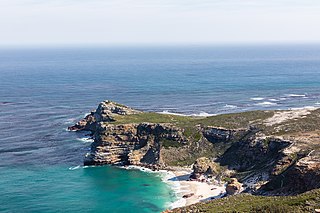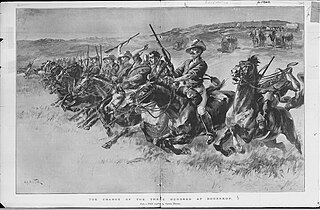| |||||||||
| Decades: | |||||||||
|---|---|---|---|---|---|---|---|---|---|
| See also: | |||||||||
The following lists events that happened during 1805 in South Africa .
| |||||||||
| Decades: | |||||||||
|---|---|---|---|---|---|---|---|---|---|
| See also: | |||||||||
The following lists events that happened during 1805 in South Africa .

Boers are the descendants of the proto Afrikaans-speaking Free Burghers of the eastern Cape frontier in Southern Africa during the 17th, 18th, and 19th centuries. From 1652 to 1795, the Dutch East India Company controlled the Dutch Cape Colony, which the United Kingdom incorporated into the British Empire in 1806. The name of the group is derived from Trekboer then later "boer", which means "farmer" in Dutch and Afrikaans.

Cape Town is the legislative capital of South Africa. It is the country's oldest city and the seat of the Parliament of South Africa. It is the country's second-largest city, after Johannesburg, and the largest in the Western Cape. The city is part of the City of Cape Town metropolitan municipality.

Robben Island is an island in Table Bay, 6.9 kilometres (4.3 mi) west of the coast of Bloubergstrand, north of Cape Town, South Africa. It takes its name from the Dutch word for seals (robben), hence the Dutch/Afrikaans name Robbeneiland, which translates to Seal(s) Island.

The Cape of Good Hope is a rocky headland on the Atlantic coast of the Cape Peninsula in South Africa.

The Cape Colony, also known as the Cape of Good Hope, was a British colony in present-day South Africa named after the Cape of Good Hope. It existed from 1795 to 1802, and again from 1806 to 1910, when it united with three other colonies to form the Union of South Africa, then became the Cape Province, which existed even after 1961, when South Africa had become a republic, albeit, temporarily outside the Commonwealth of Nations (1961–94).

The Union of South Africa was the historical predecessor to the present-day Republic of South Africa. It came into existence on 31 May 1910 with the unification of the Cape, Natal, Transvaal, and Orange River colonies. It included the territories that were formerly part of the South African Republic and the Orange Free State.

The first modern humans are believed to have inhabited South Africa more than 100,000 years ago. South Africa's first known inhabitants have been collectively referred to as the Khoisan, the Khoekhoe and the San. Starting in about 400 AD, these groups were then joined by the Bantu ethnic groups who migrated from Western and Central Africa during what is known as the Bantu expansion. These Bantu groups were mainly limited to the area north of the Soutpansberg and the northeastern part of South Africa until the later Middle Iron Age, after which they started migrating south into the interior of the country.

The Jameson Raid was a botched raid against the South African Republic carried out by British colonial administrator Leander Starr Jameson, under the employment of Cecil Rhodes. It involved 500 British South Africa Company police and was launched from Rhodesia over the New Year weekend of 1895–96. Paul Kruger, for whom Rhodes had great personal hatred, was president of the South African Republic at the time. The raid was intended to trigger an uprising by the primarily British expatriate workers in the Transvaal but it failed.

The Great Trek was a northward migration of Dutch-speaking settlers who travelled by wagon trains from the Cape Colony into the interior of modern South Africa from 1836 onwards, seeking to live beyond the Cape's British colonial administration. The Great Trek resulted from the culmination of tensions between rural descendants of the Cape's original European settlers, known collectively as Boers, and the British. It was also reflective of an increasingly common trend among individual Boer communities to pursue an isolationist and semi-nomadic lifestyle away from the developing administrative complexities in Cape Town. Boers who took part in the Great Trek identified themselves as voortrekkers, meaning "pioneers" or "pathfinders" in Dutch and Afrikaans.

Coloureds are multiracial people in South Africa, Namibia and to a lesser extent, Zimbabwe and Zambia. Their ancestry descends from the interracial marriages/interracial unions that occurred between Europeans, Africans and Asians. Interracial mixing in South Africa began in the Dutch Cape Colony in the 17th century when the Dutch men mixed with Khoi Khoi women, Bantu women and Asian female slaves and mixed race children were conceived. Eventually, interracial mixing occurred throughout South Africa and the rest of Southern Africa with various other European nationals such as the Portuguese, British, Germans, and Irish, who mixed with other African tribes which contributed to the growing number of mixed-race people, who would later be officially classified as Coloured by the apartheid government.
The following lists events that happened during 1803 in South Africa.

Makhanda, formerly known as Grahamstown, is a town of about 75,000 people in the Eastern Cape province of South Africa. It is situated about 125 kilometres (80 mi) northeast of Gqeberha and 160 kilometres (100 mi) southwest of East London. It is the largest town in the Makana Local Municipality, and the seat of the municipal council. It also hosts Rhodes University, the Eastern Cape Division of the High Court, the South African Library for the Blind (SALB), a diocese of the Anglican Church of Southern Africa, and 6 South African Infantry Battalion. Furthermore, located approximately 3 km south-east of the town lies Waterloo Farm, the only estuarine fossil site in the world from 360 million years ago with exceptional soft-tissue preservation.

Railways with a track gauge of 3 ft 6 in were first constructed as horse-drawn wagonways. The first intercity passenger railway to use 3 ft 6 in was constructed in Norway by Carl Abraham Pihl. From the mid-nineteenth century, the 3 ft 6 in gauge became widespread in the British Empire. In Africa it became known as the Cape gauge as it was adopted as the standard gauge for the Cape Government Railways in 1873, although it had already been established in Australia and New Zealand before that. It was adopted as a standard in New Zealand, South Africa, Indonesia, Japan, the Philippines, Taiwan, and Queensland in Australia.
The Cape Colonial Forces (CCF) were the official defence organisation of the Cape Colony in South Africa. Established in 1855, they were taken over by the Union of South Africa in 1910, and disbanded when the Union Defence Forces were formed in 1912.

The Battle of Blaauwberg was a successful British amphibious operation during the War of the Third Coalition which lasted from 8–18 January 1806 and resulted in the capture of the Dutch Cape Colony. After defeating their Batavian opponents, the British signed a treaty under the Treaty Tree in Woodstock, Cape Town which established Britain's control over the Cape Colony. The colony later became a permanent part of the British Empire following the Congress of Vienna that marked the end of the Napoleonic Wars in 1814. Due to establishing permanent British rule over the Cape Colony, the battle would have many ramifications for southern Africa during the nineteenth and twentieth centuries. A bi-centennial commemoration of the battle was held in January 2006.
Afrikaners are a Southern African ethnic group descended from predominantly Dutch settlers first arriving at the Cape of Good Hope in 1652. Until 1994, they dominated South Africa's politics as well as the country's commercial agricultural sector.

The Dutch Cape Colony was a Dutch United East India Company (VOC) colony in Southern Africa, centered on the Cape of Good Hope, from where it derived its name. The original colony and the successive states that the colony was incorporated into occupied much of modern South Africa. Between 1652 and 1691, it was a Commandment, and between 1691 and 1795, a Governorate of the VOC. Jan van Riebeeck established the colony as a re-supply and layover port for vessels of the VOC trading with Asia. The Cape came under VOC rule from 1652 to 1795 and from 1803 to 1806 was ruled by the Batavian Republic. Much to the dismay of the shareholders of the VOC, who focused primarily on making profits from the Asian trade, the colony rapidly expanded into a settler colony in the years after its founding.

The economy of the Western Cape in South Africa is dominated by the city of Cape Town, which accounted for 72% of the Western Cape's economic activity in 2016. The single largest contributor to the region's economy is the financial and business services sector, followed by manufacturing. Close to 30% of the gross regional product comes from foreign trade with agricultural products and wine dominating exports. High-tech industries, international call centres, fashion design, advertising and TV production are niche industries rapidly gaining in importance.

Slavery in South Africa existed from 1653 in the Dutch Cape Colony until the abolition of slavery in the British Cape Colony on 1 January 1834. This followed the British banning the trade of slaves between colonies in 1807, with their emancipation by 1834. Beyond legal abolition, slavery continued in the Transvaal though a system of inboekstelsel.
The following is a timeline of the history of Cape Town in the Western Cape province of South Africa.